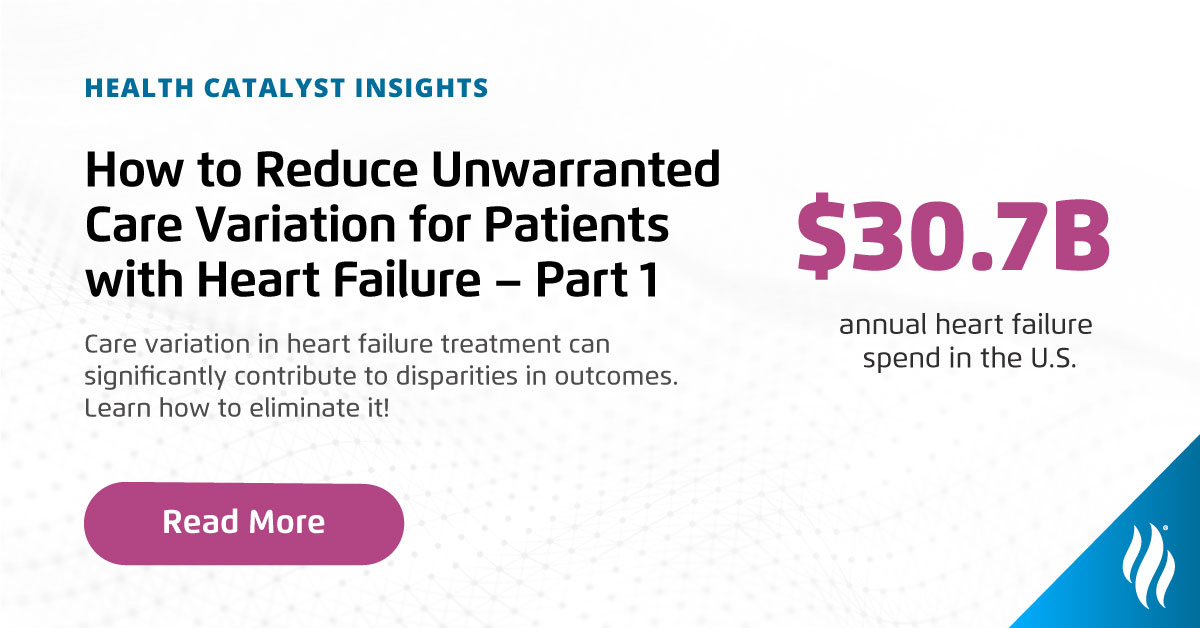Treating heart failure is complex and because of that, variation in care is common. Eliminating unwarranted variation is an important factor in delivering successful treatment of HF; however, without access to comprehensive data and clinically proven strategies, it's very difficult to achieve. This first installment on reducing care variations explores the six key advantages of leveraging a sophisticated technology platform to improve care.
 Download
Download

Heart Failure (HF) accounts for one out of every eight deaths annually, costing an estimated $30.7 billion. Many Americans diagnosed with HF also experience unnecessary variation in their medical care, which significantly contributes to disparities in clinical outcomes. Without efforts to standardize care protocols, patients are at high risk for complications.
Eliminating unwarranted care variation — that which cannot be explained by personal preference, illness, medical need, or the dictates of evidence-based medicine — drives timely, cost-efficient, and successful treatment for serious medical conditions such as HF.
Strategies that combine technical and clinical components can go a long way in combating high care costs and climbing hospital mortality rates. This two-part series outlines those best practices, along with the following:
To effectively standardize care for HF patients, an evaluation of the entire patient care environment and assessment of data capture opportunities is essential. This means uniting EHR data, cardiac imaging, ECG management systems, payer claims, material and supply use and costs, prescriptions, social determinants of health, patient satisfaction reports, and patient engagement details. These data must be integrated and normalized to create a comprehensive view of care processes and outcomes across the health system.
A robust data platform acts as the single source of truth across the system and is critical for predictive models whose accuracy depends on access to precise data. Having one source of data truth within a data platform will also prevent data silos and ensure every machine learning (ML) model uses the latest, most accurate data and not one-off data sets.
The application of ML and augmented intelligence (AI) is perfect for HF because of its complex etiology, the large number of risk factors, the high degree of comorbidity in patients, and the prolonged and progressive course of the disease. Health systems are increasingly turning to AI to help all team members make more informed decisions in a shorter time frame. AI can quickly scour millions of data sets and deliver the most relevant insight to decision-makers, including frontline clinicians and enterprise leadership.
Using the predictive model results, data science teams collaborate with operational and clinical partners to discuss and understand the new insights about their HF patient population, how to use those insights to evolve care standards and protocols, and which data they need to support workflows. AI can facilitate the management of HF across the entire continuum, including
Business intelligence dashboards summarize and present complex information to help healthcare professionals gain insights into the most critical aspects of their data. These data and analytics are most impactful when they are accessible to the entire care team. Leaders value the ability to pinpoint variation by patient location, provider, patient risk cohort, and more to enact system-level changes that improve outcomes across the entire HF patient population. Providers can also be proactive in adjusting the clinical course of treatment to affect individual outcome improvement.
Personalized dashboards deliver significant value to users with a defined sphere of influence. They promote sharing, storytelling, and a greater understanding of performance. For example, Cardiac ICU leaders appreciate a department-level view of performance that includes details such as timeliness of care metrics, workload, length of stay, and adherence to standards for acute decompensation management. Providers prefer dashboards highlighting risk-adjusted patient outcomes, compliance with standardized care processes, and performance against system-wide metrics. Pharmacists can assess adherence to guideline-directed medical therapy (GDMT) protocols and medication reconciliation processes to proactively engage providers when deviation occurs.
Studies have proven that patients who are active participants in their care experience 21% lower costs. Furthermore, patients with low health literacy levels are more likely to be admitted to the hospital or die from heart failure. Digital engagement technology is an effective strategy to help patients become active participants in their care. A series of messages delivered over time can:
Remote patient monitoring (RPM) uses technology to collect physiologic patient data such as weight, blood pressure, and oxygenation, usually from devices deployed within the home. These data provide the care team with a comprehensive view of each patient’s health between office visits. RPM has the potential to significantly improve healthcare outcomes, increase care team efficacy, and reduce healthcare costs. It also makes office visits much more valuable because clinicians can focus on evolving the patient’s medical plan of care instead of collecting data. It empowers patients to be more engaged with their own health.
RPM is particularly valuable when organizations are trying to resolve equity issues related to rural and disadvantaged populations with difficulty accessing in-person visits. The combination of a text-based messaging platform and a consumer-grade medical device ensures that valuable data is gathered — whether it’s manually entered or automatically captured via Bluetooth or cellular connectivity.
RPM can improve health outcomes for all HF patients because it provides real-time feedback, drives more timely adjustments in GDMT, and helps identify deterioration that may be addressed before a hospital visit is required.
Effective treatment for HF patients requires a cohesive clinical plan anchored by comprehensive, robust data. Sophisticated tools such as ML and AI can be applied once trust and confidence in cross-community patient data are used for these predictive models. Comprehensive HF strategies that combine technical and clinical components are successful for many healthcare organizations across the country.
Would you like to learn more about this topic? Here are some articles we suggest:
https://www.slideshare.net/healthcatalyst1/how-to-reduce-unwarranted-care-variation-in-patients-with-heart-failure-part-1